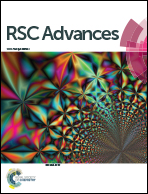One-pot gradient solvothermal synthesis of the Ag/Au–Fe3O4 composite nanoparticles and their applications
Abstract
Herein, we report for the first time a simple and reliable one-pot methodology for the facile synthesis of the Ag/Au–Fe3O4 composite NPs. The as-prepared Ag/Au–Fe3O4 composite NPs have good crystallinity and saturation magnetization (38.021 emu g−1), resulting in their magnetic recycling. They have good catalytic activity and stability during the reduction of 4-nitrophenol in the presence of NaBH4. These Ag/Au–Fe3O4 composite NPs also have good antibacterial effect for Escherichia coli O1634. Excellent SERS was also shown for the detection of 2-nitroaniline using these Ag/Au–Fe3O4 composite NPs. The nanostructure makes the Ag/Au–Fe3O4 composite NPs stable and has a high-enhancement effect for Raman detection.


 Please wait while we load your content...
Please wait while we load your content...